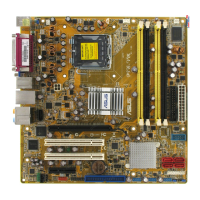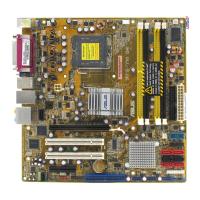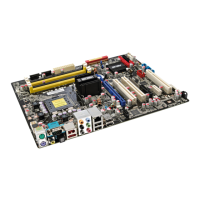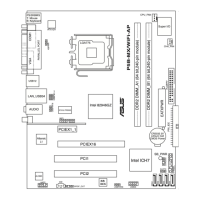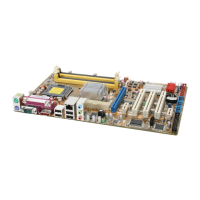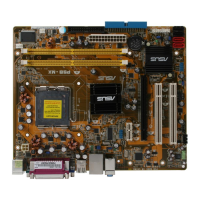Do you have a question about the Asus P5B-PLUS and is the answer not in the manual?
Statement regarding FCC compliance for the device, including operation conditions.
Statement regarding Canadian compliance for the device, including Class B limits.
Guidelines for safe electrical handling, including unplugging power.
Precautions for safe product operation, handling, and environmental factors.
Outlines the manual's structure and lists sources for more product information.
Explains symbols, text formatting, and command usage conventions in the manual.
Details CPU, Chipset, System Bus, Memory, and Expansion Slot specifications.
Covers SATA, LAN, Audio, IEEE 1394a, and USB specifications.
Details AI Lifestyle features, exclusive overclocking tools, and protection.
Lists all rear panel connectors and their types.
Covers MyLogo2, BIOS features, internal connectors, manageability, and accessories.
Greeting and checklist of items included in the motherboard package.
Covers Green ASUS, CPU support, P965 Chipset, and DDR2 memory.
Details SATA, RAID, IEEE 1394a, S/PDIF, and HD Audio features.
Introduces AI Remote, ASAP, AP Trigger, Quiet Thermal, and AI Gear.
Covers AI Nap, Q-Fan 2, Crystal Sound, Noise Filter, and EZ DIY tools.
Details EZ Flash 2, MyLogo2, AI NOS, Precision Tweaker, and C.P.R.
Table showing OS support for various ASUS features.
Safety guidelines before installation and explanation of the onboard LED.
Correct placement direction and securing the motherboard with screws.
Visual identification of motherboard components and connectors.
Lists slots, jumpers, and rear panel connectors with page references.
Detailed description of internal connectors like SATA, IDE, USB, fans.
Details the LGA775 socket and safety guidelines for CPU installation.
Detailed instructions for installing the CPU into the socket.
Aligning CPU notch and closing the retention mechanism.
Procedures for mounting the CPU heatsink and fan assembly.
Instructions for connecting the CPU fan to the motherboard header.
Step-by-step process to remove heatsink and fan.
Details DDR2 DIMM sockets, configurations, and installation guidelines.
Discusses memory limits based on OS and chipset, and compatibility notes.
Lists compatible DDR2-800MHz memory modules from various vendors.
Lists compatible DDR2-667MHz memory modules from various vendors.
Lists compatible DDR2-533MHz memory modules from various vendors.
Step-by-step guides for installing and removing RAM modules.
Procedures for physically installing and software configuring expansion cards.
Table showing IRQ assignments for motherboard devices and PCI slots.
Describes the function and compatibility of PCI, PCIe x1, and PCIe x16 slots.
Instructions for clearing CMOS settings using the CLRTC jumper.
Configures USB devices and keyboard for system wake-up.
Identifies and describes each rear panel port, including LAN LED indications.
Details USB 2.0 ports, External SATA port, and audio port functions.
Describes S/PDIF, PS/2 keyboard, and other rear panel ports.
Details internal connectors for floppy, JMicron SATA RAID, and USB.
Connectors for SATA drives and RAID configurations via ICH8R.
Details the IDE connector and its configuration options.
Connectors for USB module cables and IEEE 1394a module cable.
Connectors for CPU and chassis cooling fans, supporting Q-Fan.
Connectors for chassis intrusion detection and ATX power supply.
Connector for front panel audio modules (HD Audio/AC'97) and setup.
Connectors for optical drive audio input and S/PDIF output.
Connectors for serial port module and Trusted Platform Module.
Connects chassis-mounted functions like power LEDs, buttons, and speaker.
Instructions for installing the ASUS Q-Connector for system panel cables.
Steps for initial system power-on, POST checks, and interpreting BIOS beep codes.
Procedures for shutting down via OS and using the dual function power switch.
Overview of utilities for managing and updating the motherboard BIOS.
Step-by-step guide to update BIOS using the Internet with ASUS Update.
Step-by-step guide to update BIOS using a BIOS file with ASUS Update.
Instructions for creating bootable disks in DOS and Windows environments.
Utility for updating BIOS directly from within BIOS interface.
Utility for updating BIOS in a DOS environment and backing up current BIOS.
Steps to update BIOS using the AFUDOS utility in DOS.
Tool to restore BIOS from corrupted files using CD or USB.
Explains BIOS screen layout, menu bar, and navigation keys.
Explains menu items, sub-menus, pop-up windows, scroll bars, and help.
How to configure system time, date, and legacy floppy drive settings.
Configuring individual SATA device settings like Type, LBA Mode, and PIO Mode.
Setting SATA controller mode (IDE/AHCI/RAID) and IDE device configurations.
Shows detected BIOS, CPU, and memory information.
Settings for CPU overclocking, frequency, and voltage adjustments.
Adjusting CPU frequency, FSB, AI NOS, DRAM, and PCI Express settings.
Adjusting Memory, CPU VCore, FSB, NB, SB, and ICH Chipset voltages.
Managing USB functions, ASAP, Legacy USB, and controller mode.
Configuring TPM functions, including support and physical presence.
Displays CPU information and advanced settings like Ratio Support.
Settings for Max CPUID, TM function, Execute Disable Bit, PECI, SpeedStep.
Advanced chipset settings, including Memory Remap and Graphics Adapter initiation.
Enabling/disabling onboard controllers like Audio, 1394, LAN, SATA, Serial Port.
Settings for parallel port base address, mode, and DMA channel.
Settings for PCI/PnP devices, IRQ, and DMA assignments.
Configuring system suspend states, S3 resume, and ACPI versions.
Settings for AC power loss behavior, RTC alarm, external modems, and PCI/PCIE wake-up.
Displays CPU/MB temperatures, fan speeds, and system voltages.
Controls CPU and chassis fan speed for optimal system operation.
Defines the sequence of devices for system boot.
Settings for Quick Boot, Full Screen Logo, AddOn ROM, Num-Lock, PS/2 Mouse.
Options to display DEL message and capture Interrupt 19.
Setting Supervisor and User passwords for system security and access control.
Defining access restrictions and password check behavior.
How to launch the ASUS EZ Flash 2 utility for BIOS updates.
Storing and loading multiple BIOS overclocking profiles.
Options to save/discard changes, load default values, and exit BIOS setup.
Notes on OS compatibility and steps to launch the support CD.
Lists available device drivers for installation from the support CD.
Lists applications and utilities available for installation from the support CD.
Lists optional software like Adobe Reader, DirectX, and Skype.
Options to create Intel ICH8R or JMicron JMB363 RAID driver disks.
Steps to create RAID driver disk using BIOS setup.
Steps to create RAID driver disk using Windows interface.
Utility to customize the boot logo using images.
Monitors system vital components like fan speed, temp, and voltage.
Customizing and adjusting hardware monitor panels and sensor thresholds.
Using PCI browser and usage monitor for system resource analysis.
Launch AI Gear, AI N.O.S., AI Booster, AI Nap, and Q-Fan utilities.
Adjusts CPU freq/Vcore for performance, noise, and power saving.
Minimizes power consumption and noise when the system is idle.
Intelligently boosts performance based on system load.
Controls CPU and chassis fan speed for optimal system operation.
Overclocks CPU speed in Windows without BIOS access.
Controls media applications and system functions remotely.
Connecting and installing the USB IR receiver for AI Remote.
Re-activating remote control functionality via Device Manager.
Configuring power keys and function modes for AI Remote operation.
Setting up custom application launches for remote buttons.
Using the AP Menu and navigating application profiles with the remote.
Customizing hotkeys for non-default applications using the AI Remote software.
Table mapping remote buttons to application hotkeys.
Details the ADI AD1988 HD Audio CODEC and SoundMAX utility.
Accessing the SoundMAX control panel and using the setup wizard.
Configuring audio ports and adjusting speaker volume.
Setting audio preferences, playback/recording devices, and digital output.
Configuring speaker setup and virtual surround sound.
Optimizing microphone input settings.
Utilizing ASAP for Windows Vista performance enhancement.
Defines RAID 0, RAID 1, RAID 0+1, RAID 5, and JBOD.
Configuring RAID 0, 1, 5, 10 using Intel ICH8R.
Steps for installing SATA HDDs for RAID array creation.
Using the utility to create/manage RAID volumes.
Step-by-step guide to create a RAID 0 array.
Step-by-step guide to create a RAID 1 array.
Step-by-step guide to create a RAID 10 array.
Step-by-step guide to create a RAID 5 array.
Items needed and BIOS settings for JMicron RAID.
How to access the JMB363 RAID BIOS utility.
Steps to create RAID volumes using JMicron utility.
Steps to delete RAID sets using JMicron utility.
Reverting RAID disks to non-RAID status.
Resolving mirror conflicts in RAID 1 configuration.
Rebuilding a RAID 1 mirror drive.
How to install RAID driver during OS installation using F6 key.
Information and usage of Intel EM64T for 64-bit OS.
Information and system requirements for EIST.
Steps to enable and use EIST via BIOS and OS settings.
Information and usage of Hyper-Threading Technology.
Statement regarding FCC compliance for the device, including operation conditions.
Statement regarding Canadian compliance for the device, including Class B limits.
Guidelines for safe electrical handling, including unplugging power.
Precautions for safe product operation, handling, and environmental factors.
Outlines the manual's structure and lists sources for more product information.
Explains symbols, text formatting, and command usage conventions in the manual.
Details CPU, Chipset, System Bus, Memory, and Expansion Slot specifications.
Covers SATA, LAN, Audio, IEEE 1394a, and USB specifications.
Details AI Lifestyle features, exclusive overclocking tools, and protection.
Lists all rear panel connectors and their types.
Covers MyLogo2, BIOS features, internal connectors, manageability, and accessories.
Greeting and checklist of items included in the motherboard package.
Covers Green ASUS, CPU support, P965 Chipset, and DDR2 memory.
Details SATA, RAID, IEEE 1394a, S/PDIF, and HD Audio features.
Introduces AI Remote, ASAP, AP Trigger, Quiet Thermal, and AI Gear.
Covers AI Nap, Q-Fan 2, Crystal Sound, Noise Filter, and EZ DIY tools.
Details EZ Flash 2, MyLogo2, AI NOS, Precision Tweaker, and C.P.R.
Table showing OS support for various ASUS features.
Safety guidelines before installation and explanation of the onboard LED.
Correct placement direction and securing the motherboard with screws.
Visual identification of motherboard components and connectors.
Lists slots, jumpers, and rear panel connectors with page references.
Detailed description of internal connectors like SATA, IDE, USB, fans.
Details the LGA775 socket and safety guidelines for CPU installation.
Detailed instructions for installing the CPU into the socket.
Aligning CPU notch and closing the retention mechanism.
Procedures for mounting the CPU heatsink and fan assembly.
Instructions for connecting the CPU fan to the motherboard header.
Step-by-step process to remove heatsink and fan.
Details DDR2 DIMM sockets, configurations, and installation guidelines.
Discusses memory limits based on OS and chipset, and compatibility notes.
Lists compatible DDR2-800MHz memory modules from various vendors.
Lists compatible DDR2-667MHz memory modules from various vendors.
Lists compatible DDR2-533MHz memory modules from various vendors.
Step-by-step guides for installing and removing RAM modules.
Procedures for physically installing and software configuring expansion cards.
Table showing IRQ assignments for motherboard devices and PCI slots.
Describes the function and compatibility of PCI, PCIe x1, and PCIe x16 slots.
Instructions for clearing CMOS settings using the CLRTC jumper.
Configures USB devices and keyboard for system wake-up.
Identifies and describes each rear panel port, including LAN LED indications.
Details USB 2.0 ports, External SATA port, and audio port functions.
Describes S/PDIF, PS/2 keyboard, and other rear panel ports.
Details internal connectors for floppy, JMicron SATA RAID, and USB.
Connectors for SATA drives and RAID configurations via ICH8R.
Details the IDE connector and its configuration options.
Connectors for USB module cables and IEEE 1394a module cable.
Connectors for CPU and chassis cooling fans, supporting Q-Fan.
Connectors for chassis intrusion detection and ATX power supply.
Connector for front panel audio modules (HD Audio/AC'97) and setup.
Connectors for optical drive audio input and S/PDIF output.
Connectors for serial port module and Trusted Platform Module.
Connects chassis-mounted functions like power LEDs, buttons, and speaker.
Instructions for installing the ASUS Q-Connector for system panel cables.
Steps for initial system power-on, POST checks, and interpreting BIOS beep codes.
Procedures for shutting down via OS and using the dual function power switch.
Overview of utilities for managing and updating the motherboard BIOS.
Step-by-step guide to update BIOS using the Internet with ASUS Update.
Step-by-step guide to update BIOS using a BIOS file with ASUS Update.
Instructions for creating bootable disks in DOS and Windows environments.
Utility for updating BIOS directly from within BIOS interface.
Utility for updating BIOS in a DOS environment and backing up current BIOS.
Steps to update BIOS using the AFUDOS utility in DOS.
Tool to restore BIOS from corrupted files using CD or USB.
Explains BIOS screen layout, menu bar, and navigation keys.
Explains menu items, sub-menus, pop-up windows, scroll bars, and help.
How to configure system time, date, and legacy floppy drive settings.
Configuring individual SATA device settings like Type, LBA Mode, and PIO Mode.
Setting SATA controller mode (IDE/AHCI/RAID) and IDE device configurations.
Shows detected BIOS, CPU, and memory information.
Settings for CPU overclocking, frequency, and voltage adjustments.
Adjusting CPU frequency, FSB, AI NOS, DRAM, and PCI Express settings.
Adjusting Memory, CPU VCore, FSB, NB, SB, and ICH Chipset voltages.
Managing USB functions, ASAP, Legacy USB, and controller mode.
Configuring TPM functions, including support and physical presence.
Displays CPU information and advanced settings like Ratio Support.
Settings for Max CPUID, TM function, Execute Disable Bit, PECI, SpeedStep.
Advanced chipset settings, including Memory Remap and Graphics Adapter initiation.
Enabling/disabling onboard controllers like Audio, 1394, LAN, SATA, Serial Port.
Settings for parallel port base address, mode, and DMA channel.
Settings for PCI/PnP devices, IRQ, and DMA assignments.
Configuring system suspend states, S3 resume, and ACPI versions.
Settings for AC power loss behavior, RTC alarm, external modems, and PCI/PCIE wake-up.
Displays CPU/MB temperatures, fan speeds, and system voltages.
Controls CPU and chassis fan speed for optimal system operation.
Defines the sequence of devices for system boot.
Settings for Quick Boot, Full Screen Logo, AddOn ROM, Num-Lock, PS/2 Mouse.
Options to display DEL message and capture Interrupt 19.
Setting Supervisor and User passwords for system security and access control.
Defining access restrictions and password check behavior.
How to launch the ASUS EZ Flash 2 utility for BIOS updates.
Storing and loading multiple BIOS overclocking profiles.
Options to save/discard changes, load default values, and exit BIOS setup.
Notes on OS compatibility and steps to launch the support CD.
Lists available device drivers for installation from the support CD.
Lists applications and utilities available for installation from the support CD.
Lists optional software like Adobe Reader, DirectX, and Skype.
Options to create Intel ICH8R or JMicron JMB363 RAID driver disks.
Steps to create RAID driver disk using BIOS setup.
Steps to create RAID driver disk using Windows interface.
Utility to customize the boot logo using images.
Monitors system vital components like fan speed, temp, and voltage.
Customizing and adjusting hardware monitor panels and sensor thresholds.
Using PCI browser and usage monitor for system resource analysis.
Launch AI Gear, AI N.O.S., AI Booster, AI Nap, and Q-Fan utilities.
Adjusts CPU freq/Vcore for performance, noise, and power saving.
Minimizes power consumption and noise when the system is idle.
Intelligently boosts performance based on system load.
Controls CPU and chassis fan speed for optimal system operation.
Overclocks CPU speed in Windows without BIOS access.
Controls media applications and system functions remotely.
Connecting and installing the USB IR receiver for AI Remote.
Re-activating remote control functionality via Device Manager.
Configuring power keys and function modes for AI Remote operation.
Setting up custom application launches for remote buttons.
Using the AP Menu and navigating application profiles with the remote.
Customizing hotkeys for non-default applications using the AI Remote software.
Table mapping remote buttons to application hotkeys.
Details the ADI AD1988 HD Audio CODEC and SoundMAX utility.
Accessing the SoundMAX control panel and using the setup wizard.
Configuring audio ports and adjusting speaker volume.
Setting audio preferences, playback/recording devices, and digital output.
Configuring speaker setup and virtual surround sound.
Optimizing microphone input settings.
Utilizing ASAP for Windows Vista performance enhancement.
Defines RAID 0, RAID 1, RAID 0+1, RAID 5, and JBOD.
Configuring RAID 0, 1, 5, 10 using Intel ICH8R.
Steps for installing SATA HDDs for RAID array creation.
Using the utility to create/manage RAID volumes.
Step-by-step guide to create a RAID 0 array.
Step-by-step guide to create a RAID 1 array.
Step-by-step guide to create a RAID 10 array.
Step-by-step guide to create a RAID 5 array.
Items needed and BIOS settings for JMicron RAID.
How to access the JMB363 RAID BIOS utility.
Steps to create RAID volumes using JMicron utility.
Steps to delete RAID sets using JMicron utility.
Reverting RAID disks to non-RAID status.
Resolving mirror conflicts in RAID 1 configuration.
Rebuilding a RAID 1 mirror drive.
How to install RAID driver during OS installation using F6 key.
Information and usage of Intel EM64T for 64-bit OS.
Information and system requirements for EIST.
Steps to enable and use EIST via BIOS and OS settings.
Information and usage of Hyper-Threading Technology.
| ECC | No |
|---|---|
| Non-ECC | Yes |
| Number of memory slots | 4 |
| Maximum internal memory | 8 GB |
| Processor socket | LGA 775 (Socket T) |
| Processor manufacturer | Intel |
| USB 2.0 connectors | 2 |
| Number of COM connectors | 1 |
| Number of SATA connectors | 6 |
| Special features | ASUS MyLogo 2 ASUS AI Gear ASUS Q-Fan 2 |
| Controller interface type | Serial ATA I/II |
| Controller 2nd interface type | UltraDMA 133/100/66 |
| USB 2.0 ports quantity | USB 2.0 ports have a data transmission speed of 480 Mbps, and are backwards compatible with USB 1.1 ports. You can connect all kinds of peripheral devices to them. |
| Motherboard form factor | ATX |
| Bundled software | Drivers ASUS PC Probe II ASUS Update ASUS AI Suite Anti Virus (OEM) |
| Networking features | Gigabit Ethernet |
| BIOS memory size | 64 Mbit |
| RAID levels | 0, 1, 10 |
| Depth | 228.6 mm |
|---|---|
| Width | 305 mm |

